The Cambridge History of China. Vol. 12: Republican China, 1912-1949, Part 1
Подождите немного. Документ загружается.

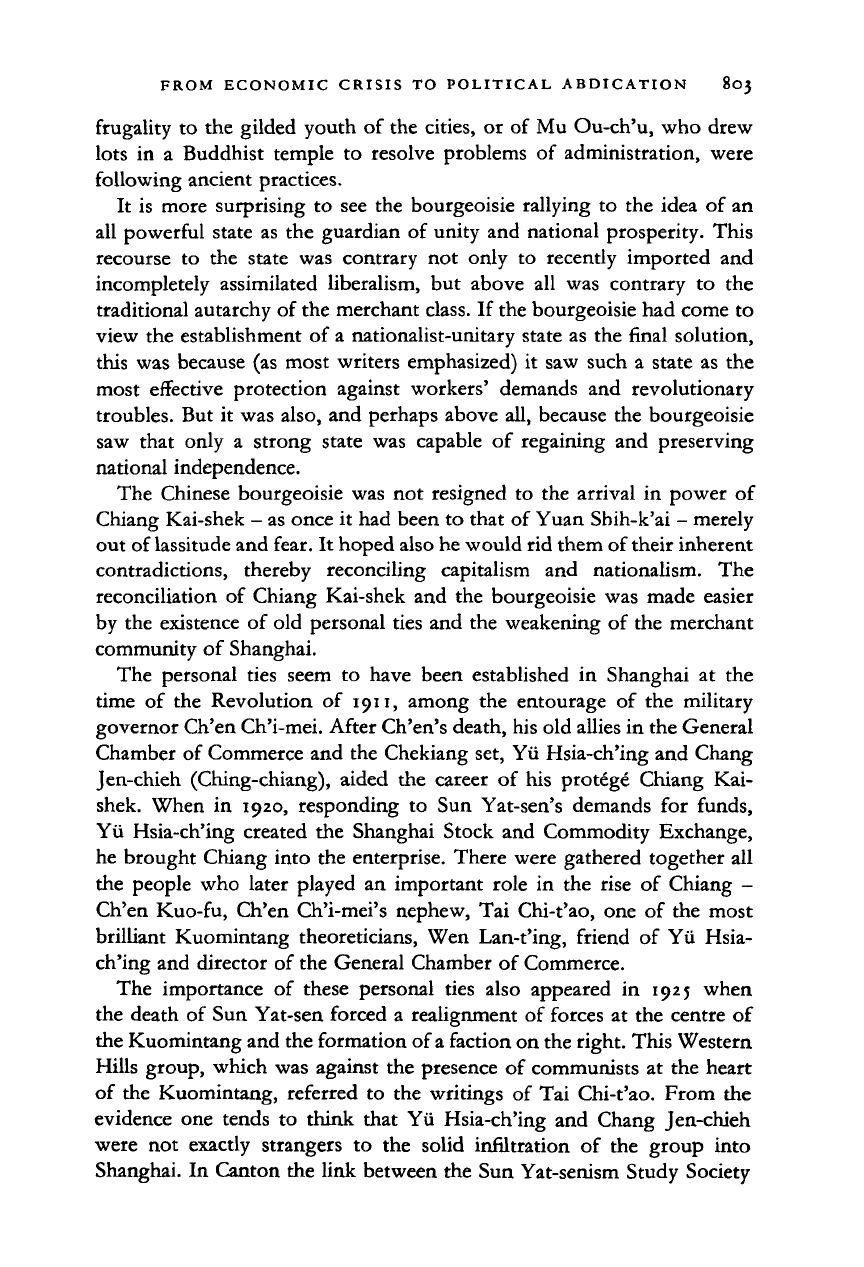
FROM ECONOMIC CRISIS TO POLITICAL ABDICATION 803
frugality to the gilded youth of the cities, or of Mu Ou-ch'u, who drew
lots in a Buddhist temple to resolve problems of administration, were
following ancient practices.
It is more surprising to see the bourgeoisie rallying to the idea of an
all powerful state as the guardian of unity and national prosperity. This
recourse to the state was contrary not only to recently imported and
incompletely assimilated liberalism, but above all was contrary to the
traditional autarchy of the merchant class. If the bourgeoisie had come to
view the establishment of a nationalist-unitary state as the final solution,
this was because (as most writers emphasized) it saw such a state as the
most effective protection against workers' demands and revolutionary
troubles. But it was also, and perhaps above all, because the bourgeoisie
saw that only a strong state was capable of regaining and preserving
national independence.
The Chinese bourgeoisie was not resigned to the arrival in power of
Chiang Kai-shek - as once it had been to that of Yuan Sbih-k'ai - merely
out of lassitude and fear. It hoped also he would rid them of their inherent
contradictions, thereby reconciling capitalism and nationalism. The
reconciliation of Chiang Kai-shek and the bourgeoisie was made easier
by the existence of old personal ties and the weakening of the merchant
community of Shanghai.
The personal ties seem to have been established in Shanghai at the
time of the Revolution of 1911, among the entourage of the military
governor Ch'en Ch'i-mei. After Ch'en's death, his old allies in the General
Chamber of Commerce and the Chekiang set, Yii Hsia-ch'ing and Chang
Jen-chieh (Ching-chiang), aided the career of his protege Chiang Kai-
shek. When in 1920, responding to Sun Yat-sen's demands for funds,
Yii Hsia-ch'ing created the Shanghai Stock and Commodity Exchange,
he brought Chiang into the enterprise. There were gathered together all
the people who later played an important role in the rise of Chiang -
Ch'en Kuo-fu, Ch'en Ch'i-mei's nephew, Tai Chi-t'ao, one of the most
brilliant Kuomintang theoreticians, Wen Lan-t'ing, friend of Yii Hsia-
ch'ing and director of the General Chamber of Commerce.
The importance of these personal ties also appeared in 1925 when
the death of Sun Yat-sen forced a realignment of forces at the centre of
the Kuomintang and the formation of a faction on the right. This Western
Hills group, which was against the presence of communists at the heart
of the Kuomintang, referred to the writings of Tai Chi-t'ao. From the
evidence one tends to think that Yii Hsia-ch'ing and Chang Jen-chieh
were not exactly strangers to the solid infiltration of the group into
Shanghai. In Canton the link between the Sun Yat-senism Study Society
Cambridge Histories Online © Cambridge University Press, 2008
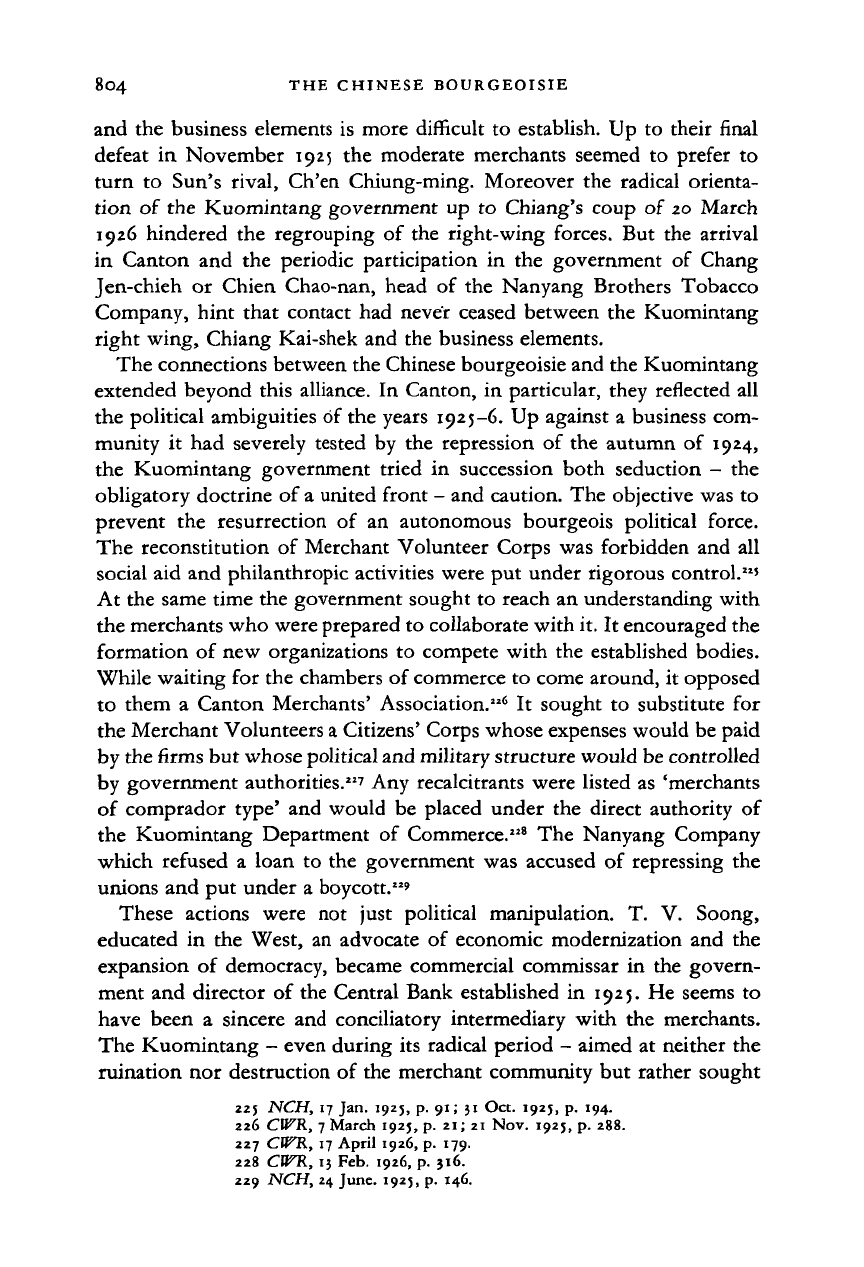
804 THE CHINESE BOURGEOISIE
and the business elements is more difficult to establish. Up to their final
defeat in November 1925 the moderate merchants seemed to prefer to
turn to Sun's rival, Ch'en Chiung-ming. Moreover the radical orienta-
tion of the Kuomintang government up to Chiang's coup of 20 March
1926 hindered the regrouping of the right-wing forces. But the arrival
in Canton and the periodic participation in the government of Chang
Jen-chieh or Chien Chao-nan, head of the Nanyang Brothers Tobacco
Company, hint that contact had never ceased between the Kuomintang
right wing, Chiang Kai-shek and the business elements.
The connections between the Chinese bourgeoisie and the Kuomintang
extended beyond this alliance. In Canton, in particular, they reflected all
the political ambiguities of the years 1925-6. Up against a business com-
munity it had severely tested by the repression of the autumn of 1924,
the Kuomintang government tried in succession both seduction - the
obligatory doctrine of a united front - and caution. The objective was to
prevent the resurrection of an autonomous bourgeois political force.
The reconstitution of Merchant Volunteer Corps was forbidden and all
social aid and philanthropic activities were put under rigorous control."
5
At the same time the government sought to reach an understanding with
the merchants who were prepared to collaborate with it. It encouraged the
formation of new organizations to compete with the established bodies.
While waiting for the chambers of commerce to come around, it opposed
to them a Canton Merchants' Association."
6
It sought to substitute for
the Merchant Volunteers a Citizens' Corps whose expenses would be paid
by the firms but whose political and military structure would be controlled
by government authorities."
7
Any recalcitrants were listed as 'merchants
of comprador type' and would be placed under the direct authority of
the Kuomintang Department of Commerce."
8
The Nanyang Company
which refused a loan to the government was accused of repressing the
unions and put under a boycott."'
These actions were not just political manipulation. T. V. Soong,
educated in the West, an advocate of economic modernization and the
expansion of democracy, became commercial commissar in the govern-
ment and director of the Central Bank established in 1925. He seems to
have been a sincere and conciliatory intermediary with the merchants.
The Kuomintang - even during its radical period - aimed at neither the
ruination nor destruction of the merchant community but rather sought
225
NCH,
17
Jan.
1925,
p.
91;
}i
Oct.
1925,
p.
194.
226
CWK,
7
March
1925,
p.
21;
21 Nov.
1925,
p.
288.
227
CWK,
17 April
1926,
p.
179.
228
CWK,
13
Feb.
1926,
p.
516.
229
NCH,
24
June.
1925,
p.
146.
Cambridge Histories Online © Cambridge University Press, 2008
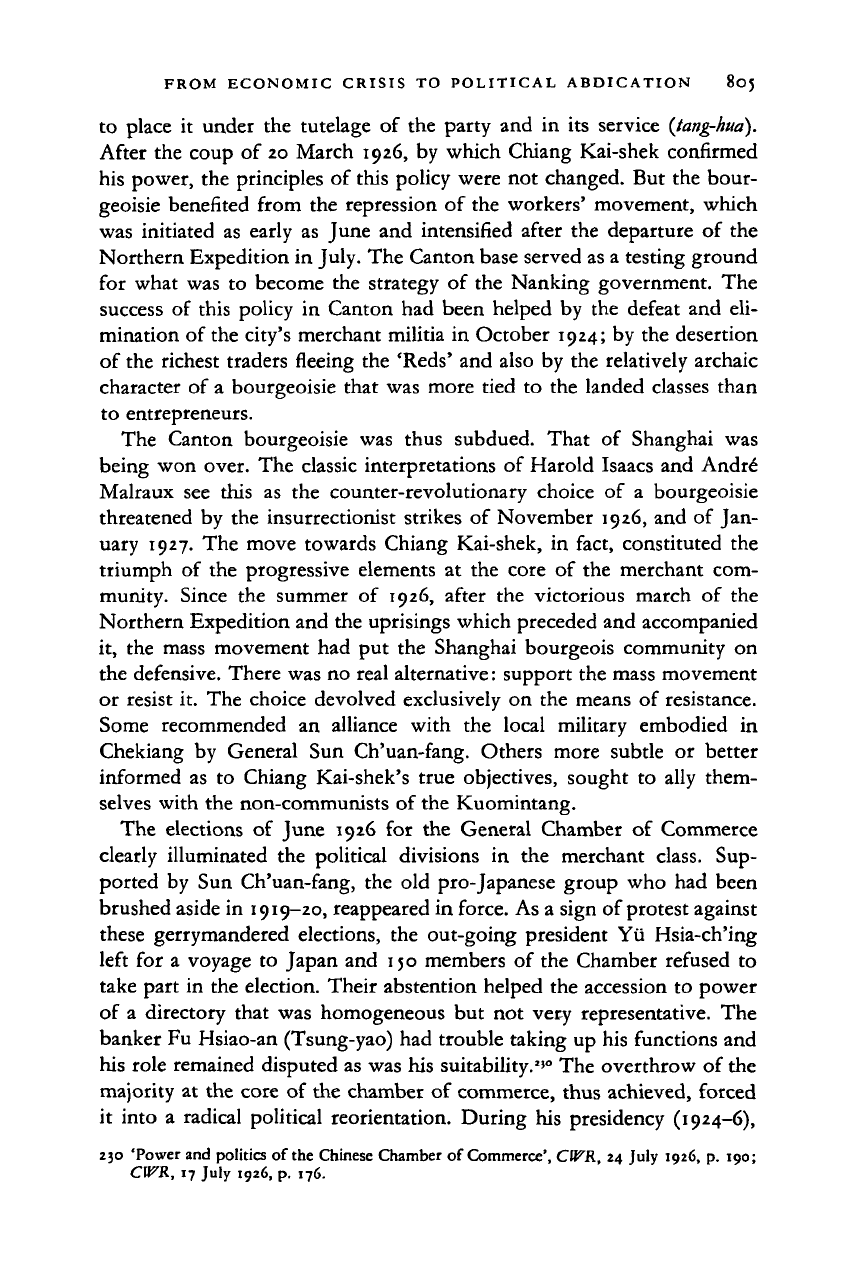
FROM ECONOMIC CRISIS TO POLITICAL ABDICATION 805
to place it under the tutelage of the party and in its service
{tang-hud).
After the coup of 20 March 1926, by which Chiang Kai-shek confirmed
his power, the principles of this policy were not changed. But the bour-
geoisie benefited from the repression of the workers' movement, which
was initiated as early as June and intensified after the departure of the
Northern Expedition in July. The Canton base served as a testing ground
for what was to become the strategy of the Nanking government. The
success of this policy in Canton had been helped by the defeat and eli-
mination of the city's merchant militia in October 1924; by the desertion
of the richest traders fleeing the 'Reds' and also by the relatively archaic
character of a bourgeoisie that was more tied to the landed classes than
to entrepreneurs.
The Canton bourgeoisie was thus subdued. That of Shanghai was
being won over. The classic interpretations of Harold Isaacs and Andr£
Malraux see this as the counter-revolutionary choice of a bourgeoisie
threatened by the insurrectionist strikes of November 1926, and of Jan-
uary 1927. The move towards Chiang Kai-shek, in fact, constituted the
triumph of the progressive elements at the core of the merchant com-
munity. Since the summer of 1926, after the victorious march of the
Northern Expedition and the uprisings which preceded and accompanied
it, the mass movement had put the Shanghai bourgeois community on
the defensive. There was no real alternative: support the mass movement
or resist it. The choice devolved exclusively on the means of resistance.
Some recommended an alliance with the local military embodied in
Chekiang by General Sun Ch'uan-fang. Others more subtle or better
informed as to Chiang Kai-shek's true objectives, sought to ally them-
selves with the non-communists of the Kuomintang.
The elections of June 1926 for the General Chamber of Commerce
clearly illuminated the political divisions in the merchant class. Sup-
ported by Sun Ch'uan-fang, the old pro-Japanese group who had been
brushed aside in 1919-20, reappeared in force. As a sign of protest against
these gerrymandered elections, the out-going president Yii Hsia-ch'ing
left for a voyage to Japan and 150 members of the Chamber refused to
take part in the election. Their abstention helped the accession to power
of a directory that was homogeneous but not vety representative. The
banker Fu Hsiao-an (Tsung-yao) had trouble taking up his functions and
his role remained disputed as was his suitability.
2
»°
The overthrow of the
majority at the core of the chamber of commerce, thus achieved, forced
it into a radical political reorientation. During his presidency (1924-6),
230 'Power and politics of the Chinese Chamber of Commerce', CWR, 24 July 1926, p. 190;
Cl^K, 17 July 1926, p. 176.
Cambridge Histories Online © Cambridge University Press, 2008
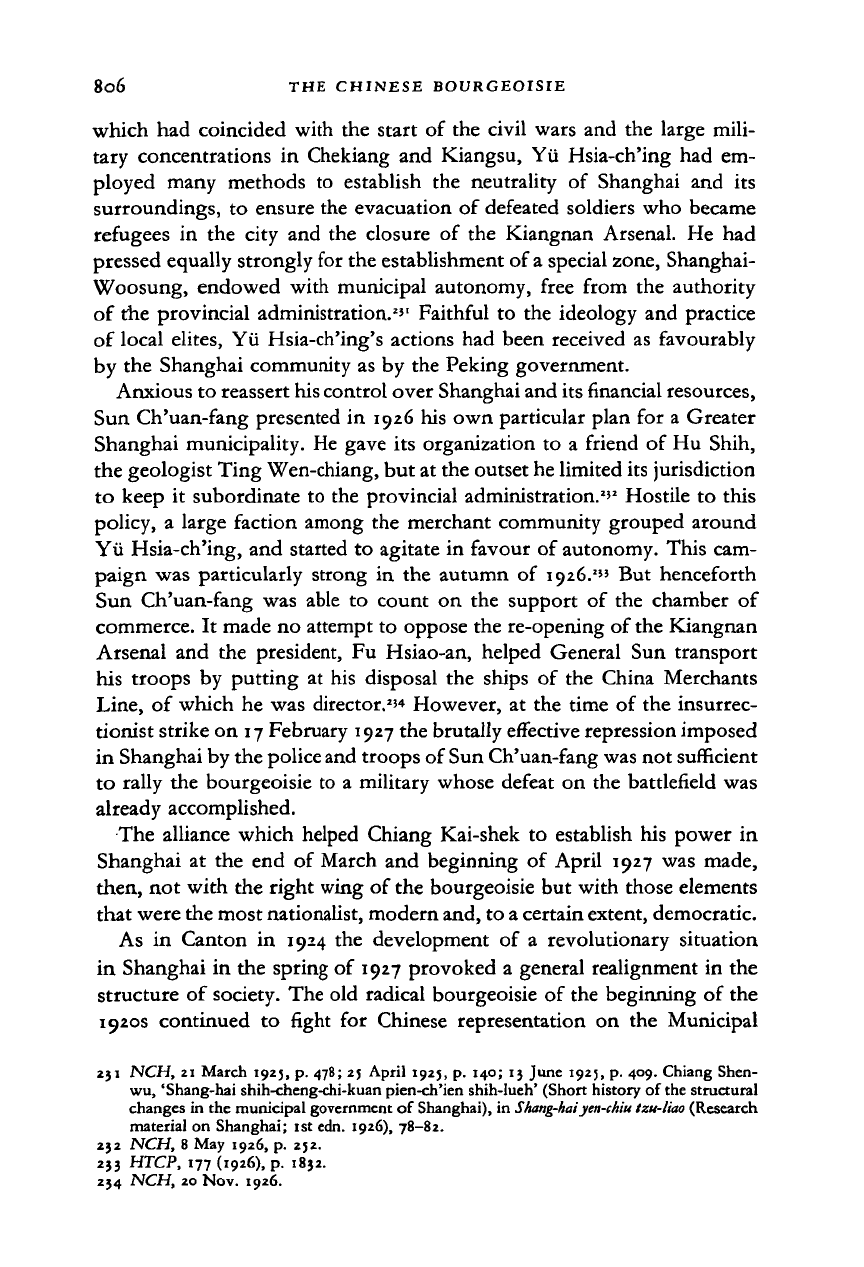
806 THE CHINESE BOURGEOISIE
which had coincided with the start of the civil wars and the large mili-
tary concentrations in Chekiang and Kiangsu, Yii Hsia-ch'ing had em-
ployed many methods to establish the neutrality of Shanghai and its
surroundings, to ensure the evacuation of defeated soldiers who became
refugees in the city and the closure of the Kiangnan Arsenal. He had
pressed equally strongly for the establishment of
a
special zone, Shanghai-
Woosung, endowed with municipal autonomy, free from the authority
of the provincial administration.
2
'
1
Faithful to the ideology and practice
of local elites, Yii Hsia-ch'ing's actions had been received as favourably
by the Shanghai community as by the Peking government.
Anxious to reassert his control over Shanghai and its financial resources,
Sun Ch'uan-fang presented in 1926 his own particular plan for a Greater
Shanghai municipality. He gave its organization to a friend of Hu Shih,
the geologist Ting Wen-chiang, but at the outset he limited its jurisdiction
to keep it subordinate to the provincial administration.
2
'
2
Hostile to this
policy, a large faction among the merchant community grouped around
Yia Hsia-ch'ing, and started to agitate in favour of autonomy. This cam-
paign was particularly strong in the autumn of 1926.
2
'' But henceforth
Sun Ch'uan-fang was able to count on the support of the chamber of
commerce. It made no attempt to oppose the re-opening of the Kiangnan
Arsenal and the president, Fu Hsiao-an, helped General Sun transport
his troops by putting at his disposal the ships of the China Merchants
Line,
of which he was director.
2
'* However, at the time of the insurrec-
tionist strike on 17 February 1927 the brutally effective repression imposed
in Shanghai by the police and troops of Sun Ch'uan-fang was not sufficient
to rally the bourgeoisie to a military whose defeat on the battlefield was
already accomplished.
The alliance which helped Chiang Kai-shek to establish his power in
Shanghai at the end of March and beginning of April 1927 was made,
then, not with the right wing of the bourgeoisie but with those elements
that were the most nationalist, modern and, to a certain extent, democratic.
As in Canton in 1924 the development of a revolutionary situation
in Shanghai in the spring of 1927 provoked a general realignment in the
structure of society. The old radical bourgeoisie of the beginning of the
1920s continued to fight for Chinese representation on the Municipal
231 NCH, 21 March 1925, p. 478; 25 April 1925, p. 140; 13 June 1925, p. 409. Chiang Shen-
wu,
'Shang-hai shih-cheng-chi-kuan pien-ch'ien shih-lueh' (Short history of the structural
changes in the municipal government of Shanghai), in
Shang-haiyen-chiu Izu-liao
(Research
material on Shanghai; 1st edn. 1926), 78-82.
232 NCH, 8 May 1926, p. 252.
233 HTCP, 177 (1926), p. 1832.
234 NCH, 20 Nov. 1926.
Cambridge Histories Online © Cambridge University Press, 2008
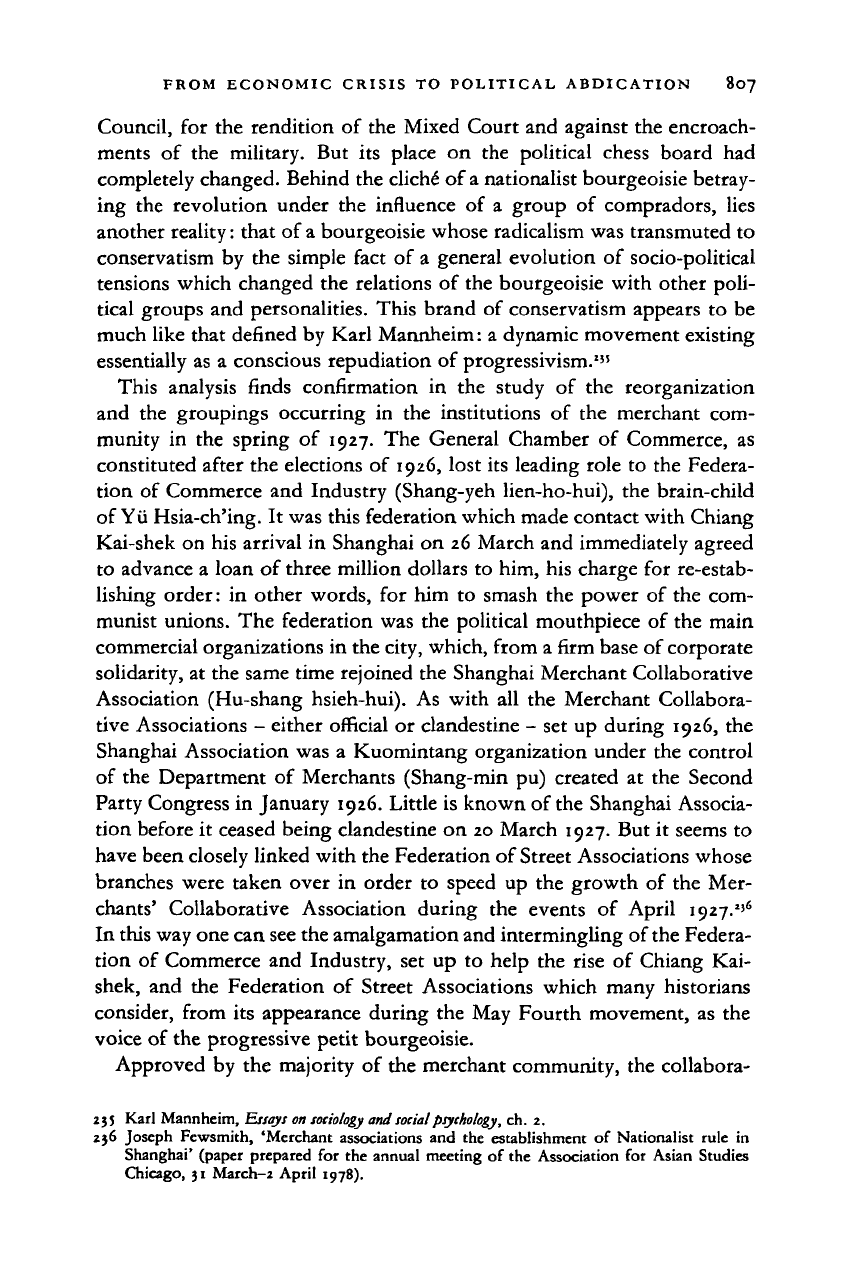
FROM ECONOMIC CRISIS TO POLITICAL ABDICATION 807
Council, for the rendition of the Mixed Court and against the encroach-
ments of the military. But its place on the political chess board had
completely changed. Behind the cliche of
a
nationalist bourgeoisie betray-
ing the revolution under the influence of a group of compradors, lies
another reality: that of a bourgeoisie whose radicalism was transmuted to
conservatism by the simple fact of a general evolution of socio-political
tensions which changed the relations of the bourgeoisie with other poli-
tical groups and personalities. This brand of conservatism appears to be
much like that denned by Karl Mannheim: a dynamic movement existing
essentially as a conscious repudiation of progressivism.
2
'
5
This analysis finds confirmation in the study of the reorganization
and the groupings occurring in the institutions of the merchant com-
munity in the spring of 1927. The General Chamber of Commerce, as
constituted after the elections of 1926, lost its leading role to the Federa-
tion of Commerce and Industry (Shang-yeh lien-ho-hui), the brain-child
of Yii Hsia-ch'ing. It was this federation which made contact with Chiang
Kai-shek on his arrival in Shanghai on 26 March and immediately agreed
to advance a loan of three million dollars to him, his charge for re-estab-
lishing order: in other words, for him to smash the power of the com-
munist unions. The federation was the political mouthpiece of the main
commercial organizations in the city, which, from a firm base of corporate
solidarity, at the same time rejoined the Shanghai Merchant Collaborative
Association (Hu-shang hsieh-hui). As with all the Merchant Collabora-
tive Associations - either official or clandestine - set up during 1926, the
Shanghai Association was a Kuomintang organization under the control
of the Department of Merchants (Shang-min pu) created at the Second
Party Congress in January 1926. Little is known of the Shanghai Associa-
tion before it ceased being clandestine on 20 March 1927. But it seems to
have been closely linked with the Federation of Street Associations whose
branches were taken over in order to speed up the growth of the Mer-
chants' Collaborative Association during the events of April I927.
2
'
6
In this way one can see the amalgamation and intermingling of the Federa-
tion of Commerce and Industry, set up to help the rise of Chiang Kai-
shek, and the Federation of Street Associations which many historians
consider, from its appearance during the May Fourth movement, as the
voice of the progressive petit bourgeoisie.
Approved by the majority of the merchant community, the collabora-
235 Karl Mannheim, Essays
on sociology and
social
psychology,
ch. z.
236 Joseph Fewsmith, 'Merchant associations and the establishment of Nationalist rule in
Shanghai' (paper prepared for the annual meeting of the Association for Asian Studies
Chicago, 31 March-2 April 1978).
Cambridge Histories Online © Cambridge University Press, 2008
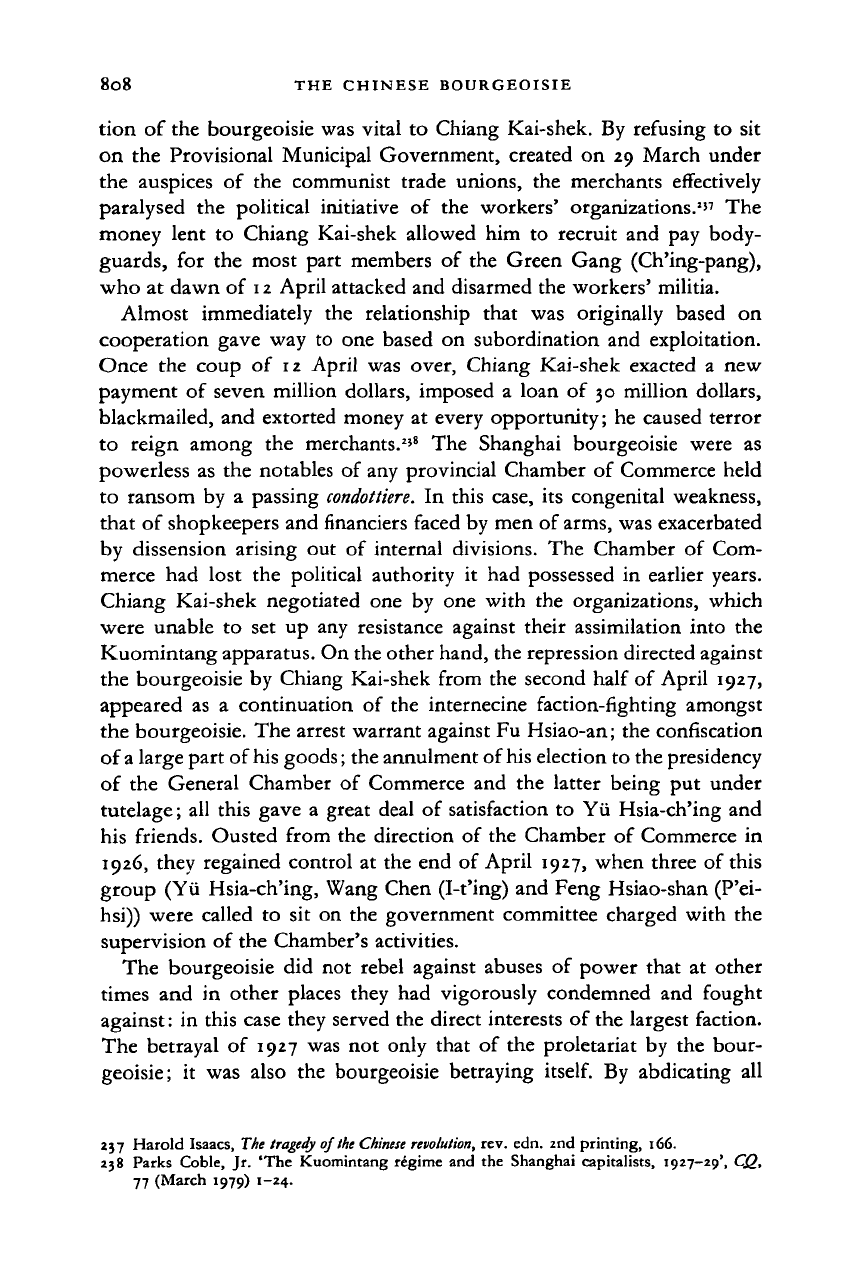
808 THE CHINESE BOURGEOISIE
tion of the bourgeoisie was vital to Chiang Kai-shek. By refusing to sit
on the Provisional Municipal Government, created on 29 March under
the auspices of the communist trade unions, the merchants effectively
paralysed the political initiative of the workers' organizations.
2
'
7
The
money lent to Chiang Kai-shek allowed him to recruit and pay body-
guards, for the most part members of the Green Gang (Ch'ing-pang),
who at dawn of 12 April attacked and disarmed the workers' militia.
Almost immediately the relationship that was originally based on
cooperation gave way to one based on subordination and exploitation.
Once the coup of 12 April was over, Chiang Kai-shek exacted a new
payment of seven million dollars, imposed a loan of 30 million dollars,
blackmailed, and extorted money at every opportunity; he caused terror
to reign among the merchants.
2
'
8
The Shanghai bourgeoisie were as
powerless as the notables of any provincial Chamber of Commerce held
to ransom by a passing
condottiere.
In this case, its congenital weakness,
that of shopkeepers and financiers faced by men of arms, was exacerbated
by dissension arising out of internal divisions. The Chamber of Com-
merce had lost the political authority it had possessed in earlier years.
Chiang Kai-shek negotiated one by one with the organizations, which
were unable to set up any resistance against their assimilation into the
Kuomintang apparatus. On the other hand, the repression directed against
the bourgeoisie by Chiang Kai-shek from the second half of April 1927,
appeared as a continuation of the internecine faction-fighting amongst
the bourgeoisie. The arrest warrant against Fu Hsiao-an; the confiscation
of a large part of his goods; the annulment of his election to the presidency
of the General Chamber of Commerce and the latter being put under
tutelage; all this gave a great deal of satisfaction to Yii Hsia-ch'ing and
his friends. Ousted from the direction of the Chamber of Commerce in
1926,
they regained control at the end of April 1927, when three of this
group (Yii Hsia-ch'ing, Wang Chen (I-t'ing) and Feng Hsiao-shan (P'ei-
hsi)) were called to sit on the government committee charged with the
supervision of the Chamber's activities.
The bourgeoisie did not rebel against abuses of power that at other
times and in other places they had vigorously condemned and fought
against: in this case they served the direct interests of the largest faction.
The betrayal of 1927 was not only that of the proletariat by the bour-
geoisie; it was also the bourgeoisie betraying
itself.
By abdicating all
237 Harold Isaacs, The
tragedy
of
the Chinese
revolution,
rev. edn. 2nd printing, 166.
238 Parks Coble, Jr. 'The Kuomintang regime and the Shanghai capitalists, 1927—29', CQ,
77 (March 1979) 1-24.
Cambridge Histories Online © Cambridge University Press, 2008
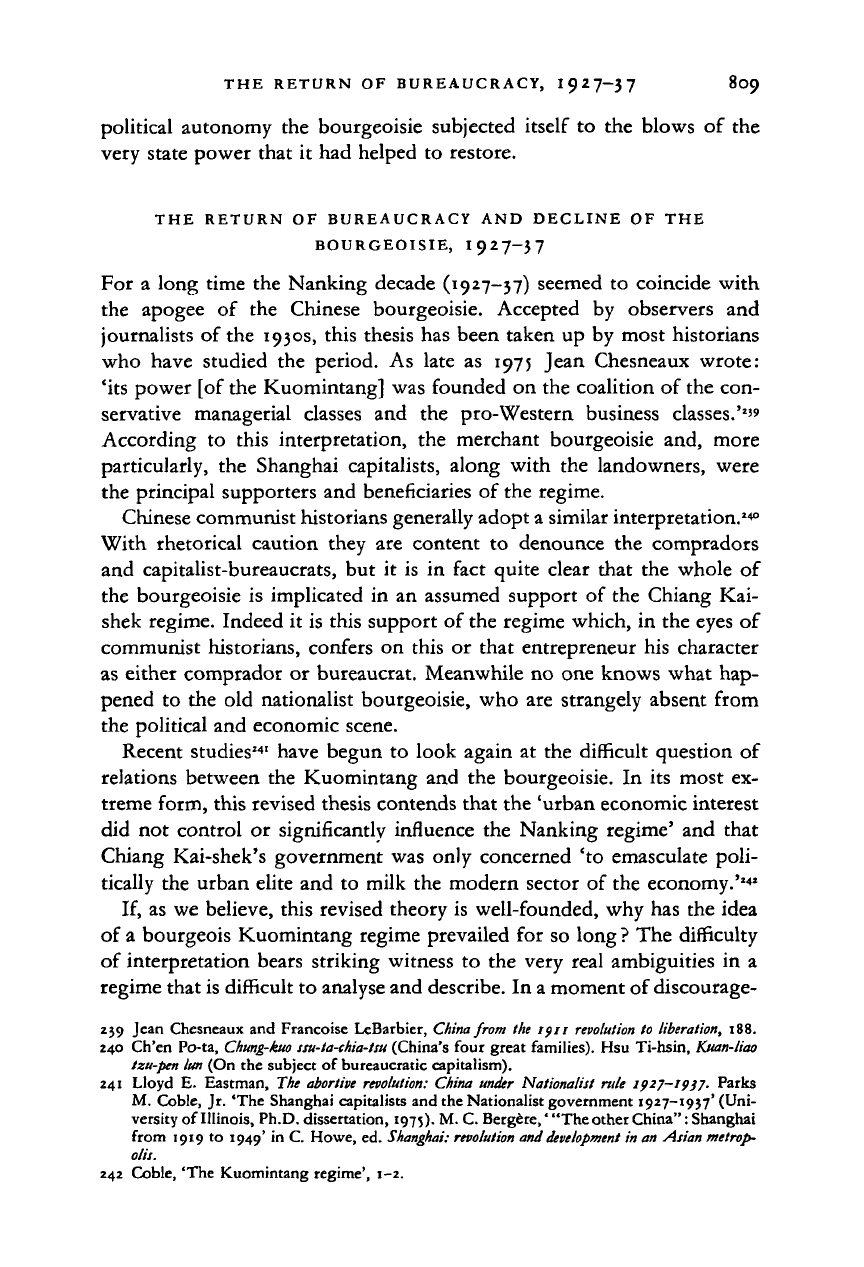
THE RETURN OF BUREAUCRACY, 1927-37 809
political autonomy the bourgeoisie subjected itself to the blows of the
very state power that it had helped to restore.
THE RETURN OF BUREAUCRACY AND DECLINE OF THE
BOURGEOISIE, 1927-37
For a long time the Nanking decade (1927-37) seemed to coincide with
the apogee of the Chinese bourgeoisie. Accepted by observers and
journalists of the 1930s, this thesis has been taken up by most historians
who have studied the period. As late as 1975 Jean Chesneaux wrote:
'its power [of the Kuomintang] was founded on the coalition of the con-
servative managerial classes and the pro-Western business classes.'
2
"
According to this interpretation, the merchant bourgeoisie and, more
particularly, the Shanghai capitalists, along with the landowners, were
the principal supporters and beneficiaries of the regime.
Chinese communist historians generally adopt a similar interpretation.
240
With rhetorical caution they are content to denounce the compradors
and capitalist-bureaucrats, but it is in fact quite clear that the whole of
the bourgeoisie is implicated in an assumed support of the Chiang Kai-
shek regime. Indeed it is this support of the regime which, in the eyes of
communist historians, confers on this or that entrepreneur his character
as either comprador or bureaucrat. Meanwhile no one knows what hap-
pened to the old nationalist bourgeoisie, who are strangely absent from
the political and economic scene.
Recent studies
241
have begun to look again at the difficult question of
relations between the Kuomintang and the bourgeoisie. In its most ex-
treme form, this revised thesis contends that the 'urban economic interest
did not control or significantly influence the Nanking regime' and that
Chiang Kai-shek's government was only concerned 'to emasculate poli-
tically the urban elite and to milk the modern sector of the economy.'
241
If, as we believe, this revised theory is well-founded, why has the idea
of a bourgeois Kuomintang regime prevailed for so long
?
The difficulty
of interpretation bears striking witness to the very real ambiguities in a
regime that is difficult to analyse and describe. In a moment of discourage-
2J9 Jean Chesneaux and Francoise LeBarbier,
China
from the 1911
revolution
to
liberation,
188.
240 Ch'en Po-ta,
Chung-kuo ssu-ta-chia-tsu
(China's four great families). Hsu Ti-hsin,
Ktum-liao
tzu-pen
lun
(On the subject of bureaucratic capitalism).
241 Lloyd E. Eastman, The abortive
revolution:
China under Nationalist rule 1927-19)7. Parks
M. Coble, Jr. 'The Shanghai capitalists and the Nationalist government 1927-1957' (Uni-
versity of Illinois, Ph.D. dissertation, 1975). M. C. Bergere,' "The other
China":
Shanghai
from 1919 to 1949' in C. Howe, ed.
Shanghai:
revolution and development
in an Asian metrop-
olis.
242 Coble, 'The Kuomintang regime', 1-2.
Cambridge Histories Online © Cambridge University Press, 2008
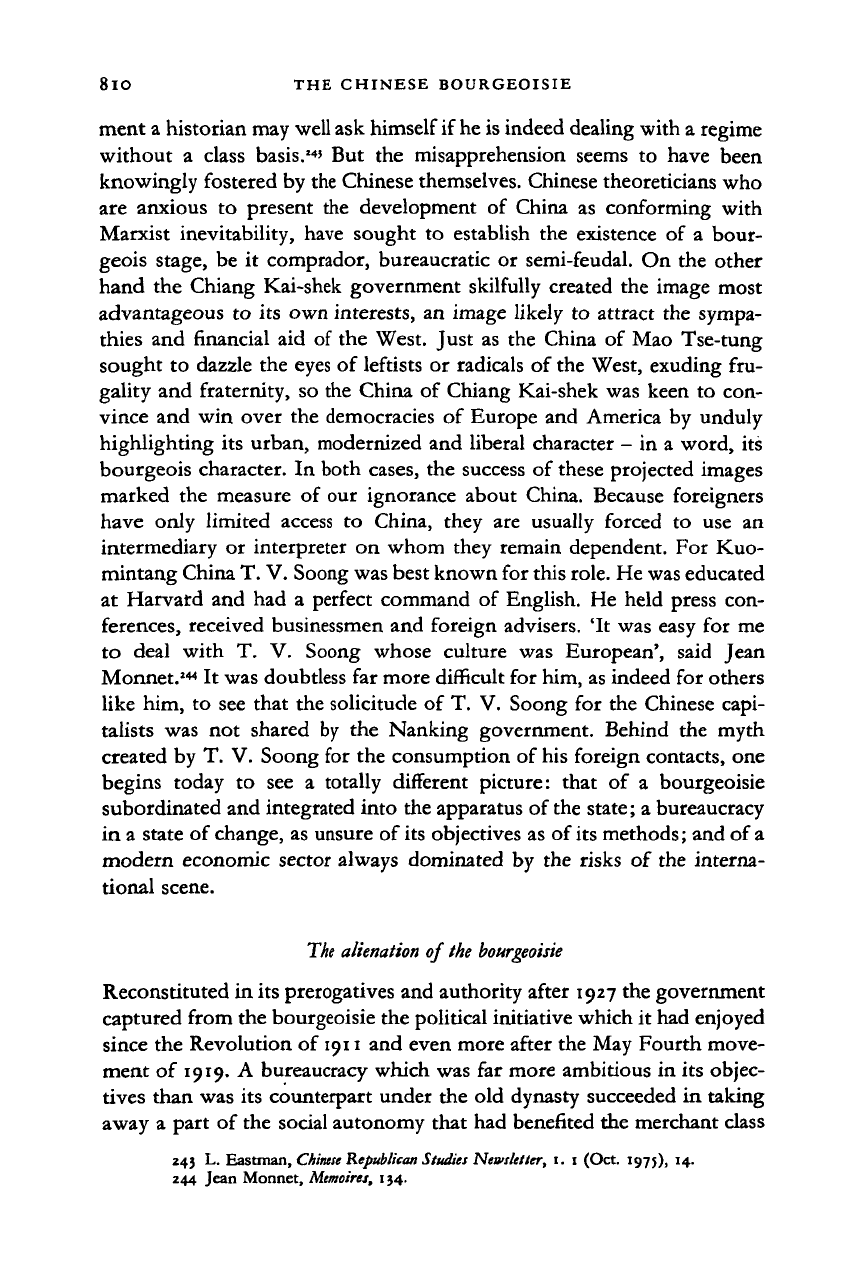
8lO THE CHINESE BOURGEOISIE
ment a historian may well ask himself
if
he is indeed dealing with
a
regime
without
a
class basis.
14
'
But the
misapprehension seems
to
have been
knowingly fostered by the Chinese themselves. Chinese theoreticians who
are anxious
to
present
the
development
of
China
as
conforming with
Marxist inevitability, have sought
to
establish
the
existence
of a
bour-
geois stage,
be it
comprador, bureaucratic
or
semi-feudal.
On the
other
hand
the
Chiang Kai-shek government skilfully created
the
image most
advantageous
to its
own interests,
an
image likely
to
attract
the
sympa-
thies
and
financial
aid of the
West. Just
as the
China
of
Mao Tse-tung
sought
to
dazzle
the
eyes
of
leftists
or
radicals
of
the West, exuding
fru-
gality
and
fraternity,
so the
China
of
Chiang Kai-shek
was
keen
to con-
vince
and win
over
the
democracies
of
Europe
and
America
by
unduly
highlighting
its
urban, modernized
and
liberal character
- in a
word,
its
bourgeois character.
In
both cases,
the
success
of
these projected images
marked
the
measure
of our
ignorance about China. Because foreigners
have only limited access
to
China, they
are
usually forced
to use an
intermediary
or
interpreter
on
whom they remain dependent.
For Kuo-
mintang China T. V. Soong was best known for this role. He was educated
at Harvard
and had a
perfect command
of
English.
He
held press
con-
ferences, received businessmen
and
foreign advisers.
'It
was easy
for me
to deal with
T. V.
Soong whose culture
was
European', said Jean
Monnet.
144
It
was doubtless
far
more difficult
for
him, as indeed
for
others
like him,
to see
that the solicitude
of
T.
V.
Soong
for the
Chinese capi-
talists
was not
shared
by the
Nanking government. Behind
the
myth
created
by T. V.
Soong
for the
consumption
of
his foreign contacts,
one
begins today
to see a
totally different picture: that
of a
bourgeoisie
subordinated and integrated into the apparatus
of
the state;
a
bureaucracy
in a state
of
change,
as
unsure
of
its objectives
as of
its
methods; and
of
a
modern economic sector always dominated
by the
risks
of the
interna-
tional scene.
The alienation of the bourgeoisie
Reconstituted
in
its prerogatives and authority after 1927 the government
captured from the bourgeoisie the political initiative which
it
had enjoyed
since
the
Revolution
of
1911
and
even more after the May Fourth move-
ment
of
1919.
A
bureaucracy which was
far
more ambitious
in
its objec-
tives than was
its
counterpart under
the old
dynasty succeeded
in
taking
away
a
part
of
the social autonomy that
had
benefited the merchant class
24}
L.
Eastman,
Chinese Republican
Studies Newsletter,
i. I (Oct.
1975),
14.
244 Jean Monnet, Mtmoiret,
134.
Cambridge Histories Online © Cambridge University Press, 2008
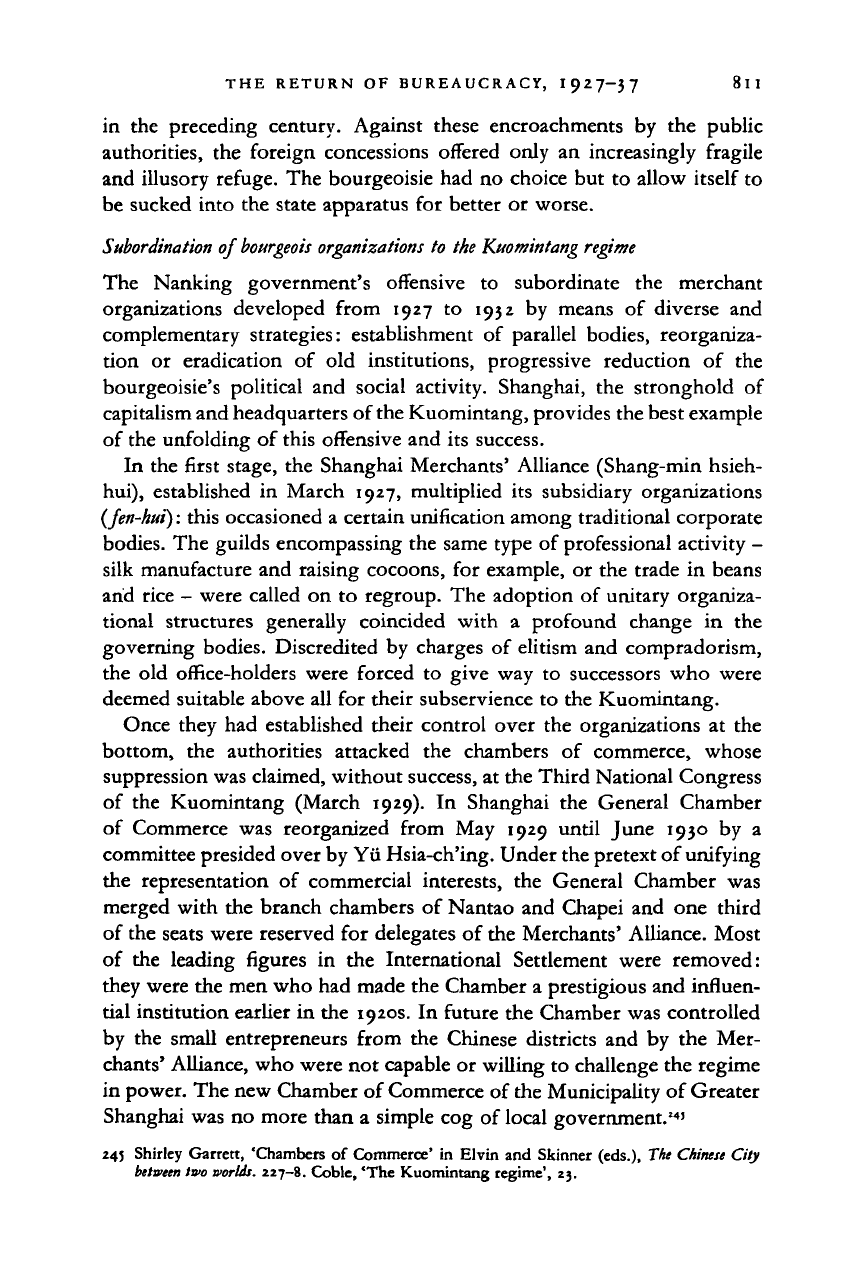
THE RETURN OF BUREAUCRACY, 1927-37 8ll
in the preceding century. Against these encroachments by the public
authorities, the foreign concessions offered only an increasingly fragile
and illusory refuge. The bourgeoisie had no choice but to allow itself to
be sucked into the state apparatus for better or worse.
Subordination of
bourgeois
organizations to the Kuomintang
regime
The Nanking government's offensive to subordinate the merchant
organizations developed from 1927 to 1932 by means of diverse and
complementary strategies: establishment of parallel bodies, reorganiza-
tion or eradication of old institutions, progressive reduction of the
bourgeoisie's political and social activity. Shanghai, the stronghold of
capitalism and headquarters of the Kuomintang, provides the best example
of the unfolding of this offensive and its success.
In the first stage, the Shanghai Merchants' Alliance (Shang-min hsieh-
hui),
established in March 1927, multiplied its subsidiary organizations
(fen-hui):
this occasioned a certain unification among traditional corporate
bodies. The guilds encompassing the same type of professional activity -
silk manufacture and raising cocoons, for example, or the trade in beans
arid rice - were called on to regroup. The adoption of unitary organiza-
tional structures generally coincided with a profound change in the
governing bodies. Discredited by charges of elitism and compradorism,
the old office-holders were forced to give way to successors who were
deemed suitable above all for their subservience to the Kuomintang.
Once they had established their control over the organizations at the
bottom, the authorities attacked the chambers of commerce, whose
suppression was claimed, without success, at the Third National Congress
of the Kuomintang (March 1929). In Shanghai the General Chamber
of Commerce was reorganized from May 1929 until June 1930 by a
committee presided over by Yu Hsia-ch'ing. Under the pretext of unifying
the representation of commercial interests, the General Chamber was
merged with the branch chambers of Nantao and Chapei and one third
of the seats were reserved for delegates of the Merchants' Alliance. Most
of the leading figures in the International Settlement were removed:
they were the men who had made the Chamber a prestigious and influen-
tial institution earlier in the 1920s. In future the Chamber was controlled
by the small entrepreneurs from the Chinese districts and by the Mer-
chants' Alliance, who were not capable or willing to challenge the regime
in power. The new Chamber of Commerce of the Municipality of Greater
Shanghai was no more than a simple cog of local government.
24
'
245 Shirley Garrett, 'Chambers of Commerce' in Elvin and Skinner (eds.), The
Chinese
City
between
two
worlds.
227-8. Coble, 'The Kuomintang regime', 23.
Cambridge Histories Online © Cambridge University Press, 2008
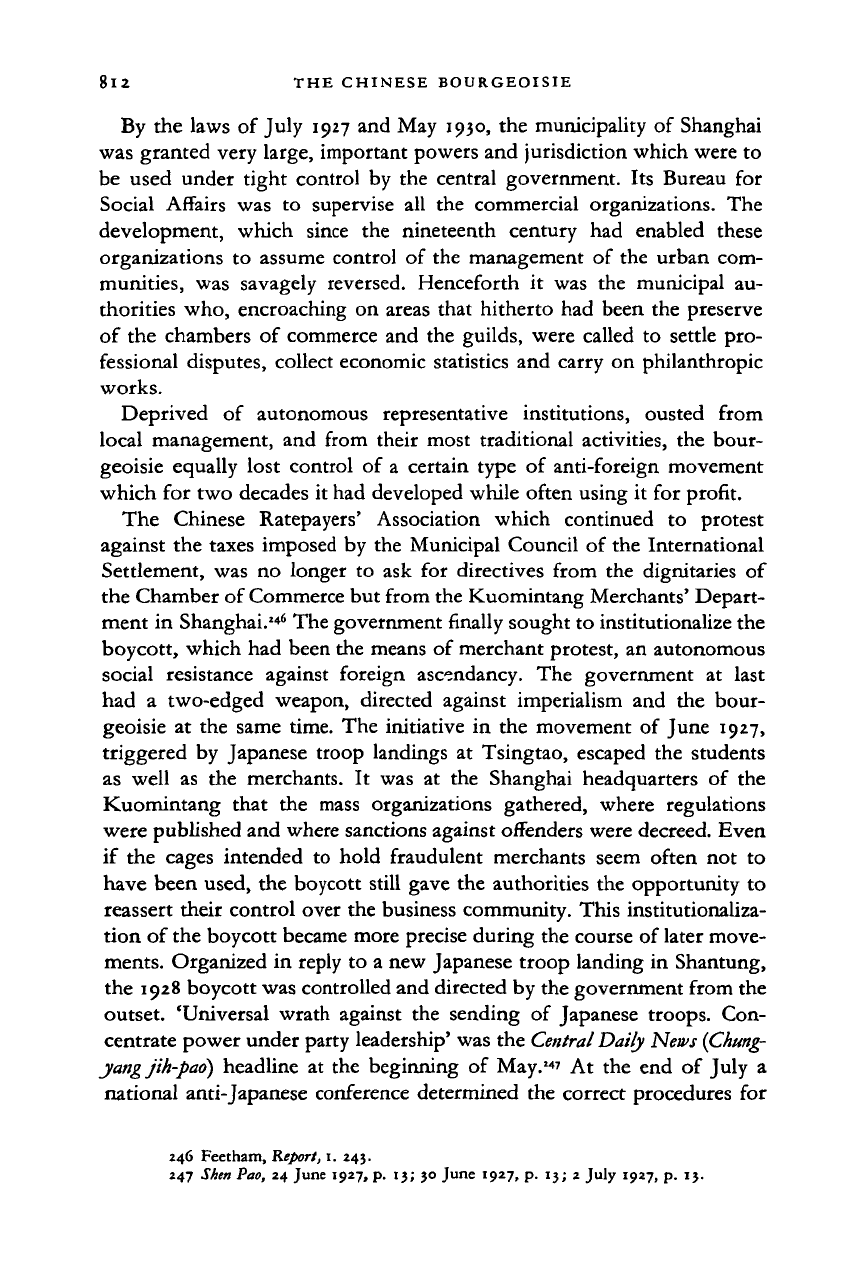
8l2 THE CHINESE BOURGEOISIE
By
the
laws
of
July 1927
and
May 1930,
the
municipality
of
Shanghai
was granted very large, important powers
and
jurisdiction which were
to
be used under tight control
by the
central government.
Its
Bureau
for
Social Affairs
was to
supervise
all the
commercial organizations.
The
development, which since
the
nineteenth century
had
enabled these
organizations
to
assume control
of the
management
of the
urban
com-
munities,
was
savagely reversed. Henceforth
it was the
municipal
au-
thorities who, encroaching
on
areas that hitherto
had
been
the
preserve
of
the
chambers
of
commerce
and the
guilds, were called
to
settle
pro-
fessional disputes, collect economic statistics
and
carry
on
philanthropic
works.
Deprived
of
autonomous representative institutions, ousted from
local management,
and
from their most traditional activities,
the
bour-
geoisie equally lost control
of a
certain type
of
anti-foreign movement
which
for
two decades
it
had developed while often using
it for
profit.
The Chinese Ratepayers' Association which continued
to
protest
against
the
taxes imposed
by the
Municipal Council
of
the International
Settlement,
was no
longer
to ask for
directives from
the
dignitaries
of
the Chamber
of
Commerce but from the Kuomintang Merchants' Depart-
ment
in
Shanghai.
2
*
6
The government finally sought
to
institutionalize the
boycott, which
had
been the means
of
merchant protest,
an
autonomous
social resistance against foreign ascendancy.
The
government
at
last
had
a
two-edged weapon, directed against imperialism
and the
bour-
geoisie
at the
same time.
The
initiative
in the
movement
of
June
1927,
triggered
by
Japanese troop landings
at
Tsingtao, escaped
the
students
as well
as the
merchants.
It was at the
Shanghai headquarters
of the
Kuomintang that
the
mass organizations gathered, where regulations
were published and where sanctions against offenders were decreed. Even
if
the
cages intended
to
hold fraudulent merchants seem often
not to
have been used,
the
boycott still gave
the
authorities
the
opportunity
to
reassert their control over
the
business community. This institutionaliza-
tion
of
the boycott became more precise during
the
course
of
later move-
ments. Organized
in
reply
to a
new Japanese troop landing
in
Shantung,
the 1928 boycott was controlled and directed
by
the government from
the
outset. 'Universal wrath against
the
sending
of
Japanese troops.
Con-
centrate power under party leadership' was the
Central Daily
News
{Chung-
yangjih-pao) headline
at the
beginning
of
May.
247
At the end of
July
a
national anti-Japanese conference determined
the
correct procedures
for
246 Feetham, Report,
1. 243.
247
Shen
Pao,
24
June 1927,
p. 13; jo
June 1927,
p.
13;
2
July 1927,
p. 13.
Cambridge Histories Online © Cambridge University Press, 2008
